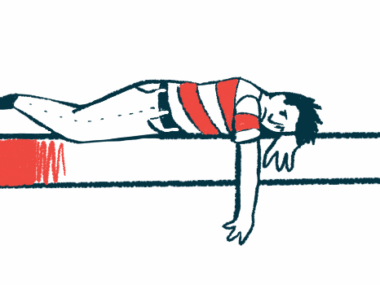Lower Quality of Life Found in Young Women With Hypermobility
Written by |

Orthostatic intolerance — a condition characterized by symptoms like dizziness, elevated heart rate, or blurred vision upon moving to an upright position — was common, and had a significant impact, among young women and adolescent girls with hypermobile Ehlers-Danlos syndrome (hEDS) and generalized hypermobility spectrum disorder (G-HSD), according to a recent study.
Moreover, most young women and teenage girls with hEDS and G-HSD who experience orthostatic intolerance also were found to have a significantly reduced quality of life.
While patient questionnaires could identify orthostatic intolerance among these respondents, however, physical tests were unable to reliably distinguish the presence of the condition between the groups, the researchers found.
“The present findings do not demonstrate a significant consistent difference in the prevalence of [orthostatic intolerance] among control, G-HSD, and hEDS participants when objectively assessed with physiological testing,” the team wrote.
“Nevertheless, the self-reported clinical orthostatic symptoms and quality-of-life questionnaires clearly indicate the majority of young women with hEDS and to slightly lesser extent G-HSD experience profound and often incapacitating orthostatic symptoms, irrespective of a formal diagnosis,” they added.
The study, “The prevalence and impact of orthostatic intolerance in young women across the hypermobility spectrum,” was published in The American Journal of Medical Genetics – Part A.
Both hEDS and G-HSD are characterized by the hallmark feature of overly mobile, or hypermobile, joints. Patients who have hypermobility but do not meet the full criteria for hEDS are often diagnosed with HSD.
Many hypermobility patients, especially adolescents, experience orthostatic intolerance — which is associated with declining functional abilities. However, the condition, often called OI, is not included in the 2017 diagnostic criteria, which also fails to list some borderline symptoms.
To learn more about OI, a research team in Australia examined the prevalence of orthostatic intolerance and quality of life in 45 girls and young women. Participants had to be between ages 14 and 30 to be included in the study. Ultimately, two-thirds had hypermobility issues.
Each of the hEDS, G-HSD and healthy volunteers groups had 15 participants. Since females account for more than 90% of hEDS patients, only females were included in the study, the team noted.
Two tests of orthostatic intolerance — assessing orthostatic hypotension and postural orthostatic tachycardia syndrome (POTS) — were each measured from two different positions: an active stand test, in which participants are asked to stand quickly, and a head-up tilt test, in which participants lie on a table and are passively tilted at different angles.
No participants were found to have orthostatic hypotension, characterized by a significant, sustained drop in blood pressure within three minutes of standing, in either test.
POTS, a sustained heart rate elevation within 10 minutes of standing, occurred in more participants with G-HSD (43%) after the head-up tilt than those with hEDS (7%) or healthy participants (7%). However, no significant difference was observed between the groups in the active stand test, in which 47% of those with G-HSD, 27% of those with hEDS, and 13% of healthy individuals experienced POTS.
“As there is no clear pattern in these responses, we consider there is insufficient evidence that the presence of POTS can be used to discriminate between individuals with hEDS and G-HSD,” the team wrote.
The difficulty in distinguishing between groups in these physical tests of orthostatic intolerance may be due to several factors, according to the researchers. One example is that the criteria for POTS differ by age group — with younger women requiring a greater heart rate increase to meet POTS criteria. Of note, a greater number of females in the hEDS group were younger than age 19.
All individuals with hEDS, 64% of those with G-HSD, and 33% of healthy participants reported orthostatic symptoms during the head-up tilt. The most common were dizziness, headache, and palpitations. Patients with hEDS or G-HSD also reported symptoms during the active stand — most commonly dizziness, leg discomfort, and visual disturbances.
In addition to the physical tests, participants filled out questionnaires relating to orthostatic symptoms and quality of life.
Results showed that those with hEDS or G-HSD had overall higher scores on symptom questionnaires than healthy participants, indicating greater orthostatic intolerance.
Quality of life was also diminished in these groups. Specifically, women over age 19 with hEDS had worse physical function, more physical limitations, more pain and fatigue, and worse general health than G-HSD and healthy participants, and worse social and emotional functioning than the healthy group. Similarly, those with G-HSD showed more fatigue and worse emotional well-being than healthy people.
Girls younger than age 19 with hEDS also had poorer physical health and lower quality of life than those in the other two groups.
“In contrast to the physical measures, the acute symptoms of OI and their longer term impact of OI on the sufferer’s quality of life revealed a clearer picture,” the researchers wrote.
“This discrepancy between objective and subjective findings … reinforces the importance of incorporating both objective and subjective measures of [orthostatic intolerance] when assessing for POTS in participants with hypermobile variants of EDS,” they added.
The team noted that more research involving a larger number of patients is needed to better understand orthostatic symptoms among women with hypermobility.
“Future work should continue to explore the influence and impact of [orthostatic intolerance] across the hypermobility spectrum, particularly in young adult and adolescent participants, and understand the mechanisms for its debilitating symptoms,” the team wrote.







